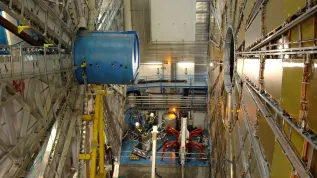
There is a clear statistical correlation between global seismic activity and changes in the intensity of cosmic radiation recorded at the surface of our planet, says the Institute of Nuclear Physics of the Polish Academy of Sciences.
It could potentially help predict earthquakes, but the correlation has to be explained first.
Strong earthquakes usually result in many human casualties and huge material losses. The scale of tragedy could be significantly reduced if we had the ability to predict the time and place of these cataclysmic events.
The CREDO project, initiated in 2016 by the Institute of Nuclear Physics of the Polish Academy of Sciences in Kraków, attempts to verify the previously known hypothesis that earthquakes could potentially be predicted by observing changes in cosmic radiation.
Statistical analyses have shown that a correlation between the two phenomena does exist, but manifests characteristics that no one had expected, representatives of the Institute of Nuclear Physics of the Polish Academy of Sciences report in a release sent to PAP - Science in Poland.
'At first glance, the idea that there is a link between earthquakes and cosmic radiation, in its primary form reaching us mainly from the Sun and deep space, may seem strange. However, its physical foundations are fully rational,’ says Dr. Piotr Homola (the Institute of Nuclear Physics PAS and AstroCeNT CAMK PAN), coordinator of CREDO and first author of the article describing the discovery in the Journal of Atmospheric and Solar-Terrestrial Physics.
The main idea here is the observation that eddy currents in the liquid core of our planet are responsible for generating the Earth's magnetic field. This field deflects the paths of charged particles of primary cosmic radiation. Thus, if large earthquakes were associated with disturbances in the flows of matter that drive the Earth's dynamo, these disturbances would alter the magnetic field, which in turn would affect the tracks of the particles of primary cosmic radiation in a manner that depends on the dynamics of the disturbances inside our planet. As a result, ground-based detectors should see some changes in the numbers of secondary cosmic ray particles detected.
According to the Institute of Nuclear Physics PAS, CREDO physicists analysed cosmic ray intensity data from two stations of the Neutron Monitor Database project (collected over the last five decades) and the Pierre Auger Observatory (collected since 2005). The choice of observatories was determined by the fact that they are located on both sides of the equator and use different detection techniques. The analyses included changes in solar activity, as described in the database maintained by the Solar Influences Data Analysis Centre. Key information on Earth's seismic activity was sourced from the U.S. Geological Survey.
The analyses were carried out using several statistical techniques. In each case, for the period studied, a clear correlation emerged between changes in the intensity of secondary cosmic radiation and the total magnitude of all earthquakes with magnitudes greater-than or equal to 4. Importantly, this correlation only becomes apparent when the cosmic ray data are shifted 15 days forward relative to the seismic data. This is good news, as it suggests the possibility of detecting impending earthquakes well in advance.
Unfortunately, the analyses do not clearly show whether it will be possible to pinpoint locations of disasters. Correlations between changes in cosmic ray intensity and earthquakes are not apparent in location-specific analyses. They only appear when seismic activity is taken into account on a global scale. This may mean that changes in cosmic ray intensity show a phenomenon to which our planet is subjected as a whole.
'In the scientific world, it is accepted that a discovery can be said to have been made when the statistical confidence level of the corroborating data reaches five sigma, or standard deviations. For the observed correlation, we obtained more than six sigma, which means a chance of less than one in a billion that the correlation is due to chance. We therefore have a very good statistical basis for claiming that we have discovered a truly existing phenomenon. The only question is, is it really the one we were expecting,’ says Dr. Homola.
It turns out that the global nature of the observed phenomenon and the 15-day advance in seismic activity evident in cosmic radiation are not the only intriguing puzzles associated with the discovery. A major surprise is the large-scale periodicity of the correlation - a phenomenon that no one had expected. Analyses show that the correlation maximum occurs every 10-11 years, a period similar to the solar activity cycle. However, it does not coincide at all with the peak activity of our star!
Furthermore, there are other common periodicities of unknown nature in both cosmic ray data and seismic data. Examples include periodic changes in seismic activity and the intensity of secondary cosmic radiation over a cycle corresponding to the Earth's stellar day (equal to 24 hours minus ~236 seconds). Could cosmic-seismic correlations be caused by some factor reaching us from outside the Solar System, capable of simultaneously producing radiation and seismic effects? What conventional physical phenomenon could even qualitatively explain the apparent correlations?
The lack of classical explanations for the observed periodicities provokes consideration of the possible role of other, less conventional phenomena. One of these could be the passage of the Earth through a dark matter stream modulated by the Sun and other massive bodies in our planetary system. The Earth, with its sensitive magnetic field, is an extremely sensitive particle detector, many times larger than human-built detectors. It is therefore reasonable to allow for the possibility that it may respond to phenomena that are invisible to existing measuring devices.
'Regardless of the source of the observed periodicities, the most important thing at this stage of the research is that we have demonstrated a link between the cosmic radiation recorded at the surface of our planet and its seismicity - and if there is anything we can be certain of, it is that our observation points to entirely new and exciting research opportunities,’ says Dr. Homola.
The international CREDO (Cosmic Ray Extremely Distributed Observatory) project is a virtual, open cosmic ray observatory that collects and processes data not only from sophisticated scientific detectors, but also from a large number of smaller detectors, including the CMOS sensors in smartphones (to turn a smartphone into a cosmic ray detector, simply install the free CREDO Detector app). One of CREDO's main tasks is to monitor global changes in the flux of secondary cosmic radiation reaching the surface of our planet. This radiation is produced in the Earth's stratosphere most intensely within the so-called Regener-Pfotzer maximum, where particles of primary cosmic radiation collide with the gas molecules of our atmosphere and initiate cascades of secondary particles.
The source information is available here (https://press.ifj.edu.pl/en/news/2023/06/14/).
PAP - Science in Poland
lt/ zan/ kap/
tr. RL













